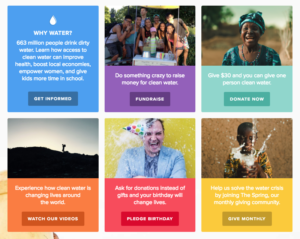
Generational targeting: From millennials to baby boomers, one message won’t compute
As business leaders and marketers, we know the importance of using different marketing strategies to reach specific audience segments.
Despite this knowledge, choosing how to group your audience effectively is mind-bending.
A strong first step is segmenting based on the age groups of your target audience — known as generational marketing.
By dividing your audience by their generational cohort, you create segments who share similar life experiences that shape how they view the world, their values, and ideals.
This information empowers you to craft a relevant message that draws a direct connection between individuals and how they relate to your brand.
The following are overviews of generational segments most commonly targeted — Baby Boomers, Generation X, and Generation Y — each with a prompt for crafting an effective message.
Messaging for baby boomers
Baby Boomers were born between 1946 and 1964, putting them at 53 to 71 years old.
They are often defined as optimists who value exploration and achievement. These traits are attributed to growing up during the Civil Rights Movement and Women’s Movement of the 60s and 70s. These free-thinkers are responsible for coining the terms “glass ceiling” and “equal opportunity workplace.”
Many are nearing retirement age of about 65, but plan on staying employed to maintain a sense of identity and purpose.
Thanks to younger generations, Baby Boomers are embracing the use of modern technology. According to a Pew Research study conducted in 2016, 61 percent of American adults aged 50–64 used Facebook.
Common generational values include individualism, community involvement, prosperity, ownership, self-actualizing, and health and wellness. Baby Boomers have the desire to achieve the goals of their youth.
Messaging Takeaway: How can you align your brand message to align with Baby Boomer’s desire to fulfill their potential?
AARP does this artfully by using phrases such as “life-re-imagined,” “disrupt aging,” “real possibilities,” and “you’ve still got it.”

Messaging for generation X
Falling in the age range of 37 to 52, Generation X was born between 1965 and 1980.
As kids, they witnessed Watergate, Three Mile Island, and the Clinton-Lewinsky scandal. Understandably, this gave them little confidence in institutions and organizations.
Generation X learned independence from a young age, as many were left in charge of their siblings while their parents worked.
When it came time for Generation X to enter the workforce in the late 80s, the country was in economic turmoil. So, despite their independent proclivity, a large percentage lived with their parents while in their 20s. The “American dream” they expected quickly turned sour.
Despite slowly developing careers, choosing to delay marriage, and postponing the decision to start a family, Gen Xers are now having children and buying homes. Likely due to their own childhood experiences, some are choosing to have one parent stay home or work part-time.
Generation X is known for bridging the gap as their use of technology and life values overlap with Baby Boomers and Generation Y, depending on which end of the spectrum they were born.
While this generation grew up during the era of emerging technology, younger Gen Xers are more reliant on it than their older peers. Typically, they use digital tools for convenience, such as online banking, rather than as a key element of their social lives.
Generation X values contribution, feedback, recognition, and autonomy. They tend to be pragmatic and individualistic, with a desire to protect themselves and those close to them. Stereotypically, they are defined as status-oriented.
Messaging Takeaway: Given Generation X’s independent thinking and skepticism of organizations, how can your brand prove its trustworthiness and help them achieve their needs?
Abound, a client of the MAC, provides guidance on schools across the US for adult degree seekers. Its trustworthiness is reinforced by phrases such as, “the colleges we work with are nationally recognized for program excellence.” A direct appeal to Gen X’s needs are made through, “get the resources, tips, and opportunities to get you moving. It’s your future — claim it.”

Messaging for generation Y
Generation Y, commonly referred to as Millennials, were born between 1980 and 1994, putting them at 23 to 37 years old.
A large percentage of this generation are not fully independent. They’re characterized by self-exploration. However, their optimistic outlook is tempered by an uncertain future characterized by crippling student loans and competitive workforce.
Millennials are frequently stamped as entitled (just don’t ever call them this). Thanks to parents who praised them no matter how well or poorly they did, they carry similar expectations into adulthood — if stereotypes are to be believed, that is.
Accustomed to rapidly developing technologies, Millennials rely on tech more than Boomers or Gen Xers and have little patience for delayed responses.
Among the generations discussed, this group is the most ethnically diverse. They value self-expression, transparency, and the pursuit of lifestyle enjoyment over wealth. Millennials want to make a difference and effect change.
Messaging Takeaway: How can your brand genuinely appeal to Millennials desire to make a difference?
Charity:water does this well by encouraging supporters to “do something crazy to raise money for clean water.” Instead of being directly targeted for a monetary donation, Millennials can start their own fundraising campaign to benefit charity:water.

Using generational targeting for effective messaging
Now, fellow marketer, you are armed with generational characteristics you can apply to segment your own audience.
When crafting your message, look at your brand through these generational lenses and ask how you can effectively reach different demographic groups.
For Baby Boomers, does your product or service help them fulfill their potential? How can you overcome Gen X’s skepticism and meet their needs? Can you support Millennials’ desire to help the greater good?
Now, go forth and send the right message to the right people.
This article is also published on Medium.
More Resources
-

Article
The Challenge of Measuring Website Accessibility NeedsAccessible digital experiences are a legal and business necessity. Yet, many organizations grapple with the question: How many people with...
-

Article
Safeguard Your Investment: the 411 on Accessible DesignHow can an organization truly serve the public if they can’t reach the whole public? In the U.S., one in...
-

Article
How to Win Over Riders with a Better Digital Transit ExperiencePublic transportation keeps our cities moving, connecting people to their jobs, schools, and favorite hangout spots. As urban areas expand...



